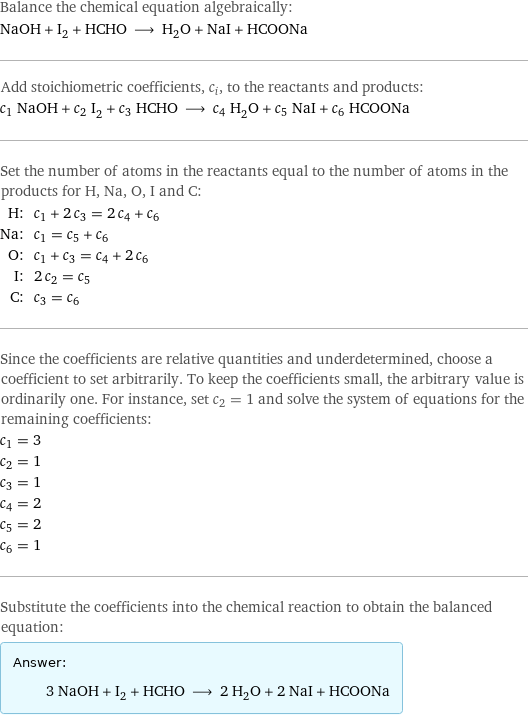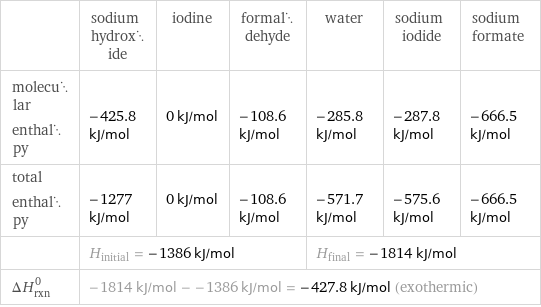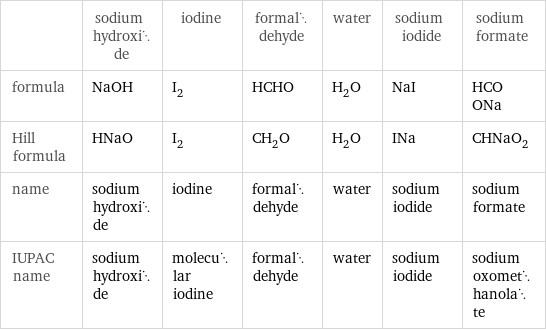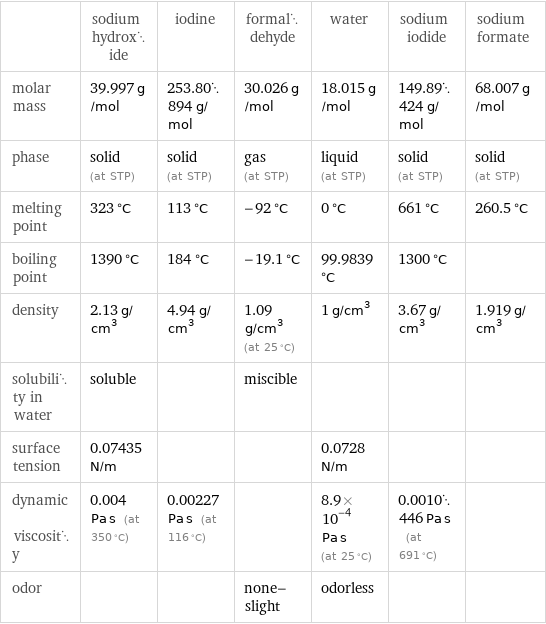Input interpretation

NaOH sodium hydroxide + I_2 iodine + HCHO formaldehyde ⟶ H_2O water + NaI sodium iodide + HCOONa sodium formate
Balanced equation

Balance the chemical equation algebraically: NaOH + I_2 + HCHO ⟶ H_2O + NaI + HCOONa Add stoichiometric coefficients, c_i, to the reactants and products: c_1 NaOH + c_2 I_2 + c_3 HCHO ⟶ c_4 H_2O + c_5 NaI + c_6 HCOONa Set the number of atoms in the reactants equal to the number of atoms in the products for H, Na, O, I and C: H: | c_1 + 2 c_3 = 2 c_4 + c_6 Na: | c_1 = c_5 + c_6 O: | c_1 + c_3 = c_4 + 2 c_6 I: | 2 c_2 = c_5 C: | c_3 = c_6 Since the coefficients are relative quantities and underdetermined, choose a coefficient to set arbitrarily. To keep the coefficients small, the arbitrary value is ordinarily one. For instance, set c_2 = 1 and solve the system of equations for the remaining coefficients: c_1 = 3 c_2 = 1 c_3 = 1 c_4 = 2 c_5 = 2 c_6 = 1 Substitute the coefficients into the chemical reaction to obtain the balanced equation: Answer: | | 3 NaOH + I_2 + HCHO ⟶ 2 H_2O + 2 NaI + HCOONa
Structures

+ + ⟶ + +
Names

sodium hydroxide + iodine + formaldehyde ⟶ water + sodium iodide + sodium formate
Reaction thermodynamics
Enthalpy

| sodium hydroxide | iodine | formaldehyde | water | sodium iodide | sodium formate molecular enthalpy | -425.8 kJ/mol | 0 kJ/mol | -108.6 kJ/mol | -285.8 kJ/mol | -287.8 kJ/mol | -666.5 kJ/mol total enthalpy | -1277 kJ/mol | 0 kJ/mol | -108.6 kJ/mol | -571.7 kJ/mol | -575.6 kJ/mol | -666.5 kJ/mol | H_initial = -1386 kJ/mol | | | H_final = -1814 kJ/mol | | ΔH_rxn^0 | -1814 kJ/mol - -1386 kJ/mol = -427.8 kJ/mol (exothermic) | | | | |
Gibbs free energy

| sodium hydroxide | iodine | formaldehyde | water | sodium iodide | sodium formate molecular free energy | -379.7 kJ/mol | 0 kJ/mol | -102.5 kJ/mol | -237.1 kJ/mol | -286.1 kJ/mol | -599.9 kJ/mol total free energy | -1139 kJ/mol | 0 kJ/mol | -102.5 kJ/mol | -474.2 kJ/mol | -572.2 kJ/mol | -599.9 kJ/mol | G_initial = -1242 kJ/mol | | | G_final = -1646 kJ/mol | | ΔG_rxn^0 | -1646 kJ/mol - -1242 kJ/mol = -404.7 kJ/mol (exergonic) | | | | |
Equilibrium constant
![Construct the equilibrium constant, K, expression for: NaOH + I_2 + HCHO ⟶ H_2O + NaI + HCOONa Plan: • Balance the chemical equation. • Determine the stoichiometric numbers. • Assemble the activity expression for each chemical species. • Use the activity expressions to build the equilibrium constant expression. Write the balanced chemical equation: 3 NaOH + I_2 + HCHO ⟶ 2 H_2O + 2 NaI + HCOONa Assign stoichiometric numbers, ν_i, using the stoichiometric coefficients, c_i, from the balanced chemical equation in the following manner: ν_i = -c_i for reactants and ν_i = c_i for products: chemical species | c_i | ν_i NaOH | 3 | -3 I_2 | 1 | -1 HCHO | 1 | -1 H_2O | 2 | 2 NaI | 2 | 2 HCOONa | 1 | 1 Assemble the activity expressions accounting for the state of matter and ν_i: chemical species | c_i | ν_i | activity expression NaOH | 3 | -3 | ([NaOH])^(-3) I_2 | 1 | -1 | ([I2])^(-1) HCHO | 1 | -1 | ([HCHO])^(-1) H_2O | 2 | 2 | ([H2O])^2 NaI | 2 | 2 | ([NaI])^2 HCOONa | 1 | 1 | [HCOONa] The equilibrium constant symbol in the concentration basis is: K_c Mulitply the activity expressions to arrive at the K_c expression: Answer: | | K_c = ([NaOH])^(-3) ([I2])^(-1) ([HCHO])^(-1) ([H2O])^2 ([NaI])^2 [HCOONa] = (([H2O])^2 ([NaI])^2 [HCOONa])/(([NaOH])^3 [I2] [HCHO])](../image_source/93b01e804e152e9afd3e1b5f2ef4a3e0.png)
Construct the equilibrium constant, K, expression for: NaOH + I_2 + HCHO ⟶ H_2O + NaI + HCOONa Plan: • Balance the chemical equation. • Determine the stoichiometric numbers. • Assemble the activity expression for each chemical species. • Use the activity expressions to build the equilibrium constant expression. Write the balanced chemical equation: 3 NaOH + I_2 + HCHO ⟶ 2 H_2O + 2 NaI + HCOONa Assign stoichiometric numbers, ν_i, using the stoichiometric coefficients, c_i, from the balanced chemical equation in the following manner: ν_i = -c_i for reactants and ν_i = c_i for products: chemical species | c_i | ν_i NaOH | 3 | -3 I_2 | 1 | -1 HCHO | 1 | -1 H_2O | 2 | 2 NaI | 2 | 2 HCOONa | 1 | 1 Assemble the activity expressions accounting for the state of matter and ν_i: chemical species | c_i | ν_i | activity expression NaOH | 3 | -3 | ([NaOH])^(-3) I_2 | 1 | -1 | ([I2])^(-1) HCHO | 1 | -1 | ([HCHO])^(-1) H_2O | 2 | 2 | ([H2O])^2 NaI | 2 | 2 | ([NaI])^2 HCOONa | 1 | 1 | [HCOONa] The equilibrium constant symbol in the concentration basis is: K_c Mulitply the activity expressions to arrive at the K_c expression: Answer: | | K_c = ([NaOH])^(-3) ([I2])^(-1) ([HCHO])^(-1) ([H2O])^2 ([NaI])^2 [HCOONa] = (([H2O])^2 ([NaI])^2 [HCOONa])/(([NaOH])^3 [I2] [HCHO])
Rate of reaction
![Construct the rate of reaction expression for: NaOH + I_2 + HCHO ⟶ H_2O + NaI + HCOONa Plan: • Balance the chemical equation. • Determine the stoichiometric numbers. • Assemble the rate term for each chemical species. • Write the rate of reaction expression. Write the balanced chemical equation: 3 NaOH + I_2 + HCHO ⟶ 2 H_2O + 2 NaI + HCOONa Assign stoichiometric numbers, ν_i, using the stoichiometric coefficients, c_i, from the balanced chemical equation in the following manner: ν_i = -c_i for reactants and ν_i = c_i for products: chemical species | c_i | ν_i NaOH | 3 | -3 I_2 | 1 | -1 HCHO | 1 | -1 H_2O | 2 | 2 NaI | 2 | 2 HCOONa | 1 | 1 The rate term for each chemical species, B_i, is 1/ν_i(Δ[B_i])/(Δt) where [B_i] is the amount concentration and t is time: chemical species | c_i | ν_i | rate term NaOH | 3 | -3 | -1/3 (Δ[NaOH])/(Δt) I_2 | 1 | -1 | -(Δ[I2])/(Δt) HCHO | 1 | -1 | -(Δ[HCHO])/(Δt) H_2O | 2 | 2 | 1/2 (Δ[H2O])/(Δt) NaI | 2 | 2 | 1/2 (Δ[NaI])/(Δt) HCOONa | 1 | 1 | (Δ[HCOONa])/(Δt) (for infinitesimal rate of change, replace Δ with d) Set the rate terms equal to each other to arrive at the rate expression: Answer: | | rate = -1/3 (Δ[NaOH])/(Δt) = -(Δ[I2])/(Δt) = -(Δ[HCHO])/(Δt) = 1/2 (Δ[H2O])/(Δt) = 1/2 (Δ[NaI])/(Δt) = (Δ[HCOONa])/(Δt) (assuming constant volume and no accumulation of intermediates or side products)](../image_source/254a785b400d96a1177cfe23f970e14b.png)
Construct the rate of reaction expression for: NaOH + I_2 + HCHO ⟶ H_2O + NaI + HCOONa Plan: • Balance the chemical equation. • Determine the stoichiometric numbers. • Assemble the rate term for each chemical species. • Write the rate of reaction expression. Write the balanced chemical equation: 3 NaOH + I_2 + HCHO ⟶ 2 H_2O + 2 NaI + HCOONa Assign stoichiometric numbers, ν_i, using the stoichiometric coefficients, c_i, from the balanced chemical equation in the following manner: ν_i = -c_i for reactants and ν_i = c_i for products: chemical species | c_i | ν_i NaOH | 3 | -3 I_2 | 1 | -1 HCHO | 1 | -1 H_2O | 2 | 2 NaI | 2 | 2 HCOONa | 1 | 1 The rate term for each chemical species, B_i, is 1/ν_i(Δ[B_i])/(Δt) where [B_i] is the amount concentration and t is time: chemical species | c_i | ν_i | rate term NaOH | 3 | -3 | -1/3 (Δ[NaOH])/(Δt) I_2 | 1 | -1 | -(Δ[I2])/(Δt) HCHO | 1 | -1 | -(Δ[HCHO])/(Δt) H_2O | 2 | 2 | 1/2 (Δ[H2O])/(Δt) NaI | 2 | 2 | 1/2 (Δ[NaI])/(Δt) HCOONa | 1 | 1 | (Δ[HCOONa])/(Δt) (for infinitesimal rate of change, replace Δ with d) Set the rate terms equal to each other to arrive at the rate expression: Answer: | | rate = -1/3 (Δ[NaOH])/(Δt) = -(Δ[I2])/(Δt) = -(Δ[HCHO])/(Δt) = 1/2 (Δ[H2O])/(Δt) = 1/2 (Δ[NaI])/(Δt) = (Δ[HCOONa])/(Δt) (assuming constant volume and no accumulation of intermediates or side products)
Chemical names and formulas

| sodium hydroxide | iodine | formaldehyde | water | sodium iodide | sodium formate formula | NaOH | I_2 | HCHO | H_2O | NaI | HCOONa Hill formula | HNaO | I_2 | CH_2O | H_2O | INa | CHNaO_2 name | sodium hydroxide | iodine | formaldehyde | water | sodium iodide | sodium formate IUPAC name | sodium hydroxide | molecular iodine | formaldehyde | water | sodium iodide | sodium oxomethanolate
Substance properties

| sodium hydroxide | iodine | formaldehyde | water | sodium iodide | sodium formate molar mass | 39.997 g/mol | 253.80894 g/mol | 30.026 g/mol | 18.015 g/mol | 149.89424 g/mol | 68.007 g/mol phase | solid (at STP) | solid (at STP) | gas (at STP) | liquid (at STP) | solid (at STP) | solid (at STP) melting point | 323 °C | 113 °C | -92 °C | 0 °C | 661 °C | 260.5 °C boiling point | 1390 °C | 184 °C | -19.1 °C | 99.9839 °C | 1300 °C | density | 2.13 g/cm^3 | 4.94 g/cm^3 | 1.09 g/cm^3 (at 25 °C) | 1 g/cm^3 | 3.67 g/cm^3 | 1.919 g/cm^3 solubility in water | soluble | | miscible | | | surface tension | 0.07435 N/m | | | 0.0728 N/m | | dynamic viscosity | 0.004 Pa s (at 350 °C) | 0.00227 Pa s (at 116 °C) | | 8.9×10^-4 Pa s (at 25 °C) | 0.0010446 Pa s (at 691 °C) | odor | | | none-slight | odorless | |
Units
